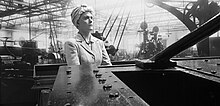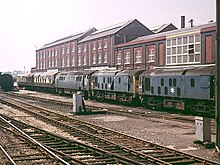Swindon Works
In 1837, Brunel recruited Daniel Gooch and gave him the job of rectifying the heavy repair burden of the GWR's mixed bag of purchased locomotives.[4][5] The GWR mainline was originally planned to cut through Savernake Forest near Marlborough, but the Marquess of Ailesbury, who owned the land, objected.With many of the early structures built and adorned by stone extracted from the construction of Box Tunnel, the first building – the locomotive repair shed – was completed in 1841 using contract labour, with the necessary machinery installed within it by 1842.Initially only employing 200 men, repairs began in 1843, with the first new locomotive, the "Premier", built in 1846 in under two weeks and renamed "Great Western".Although some rolling stock was built at Wolverhampton (producing 800 standard-gauge locomotives up to 1908), Worcester and Saltney near Chester, most of the work was concentrated at Swindon.Designed and constructed by Edward Roberts, it was completed in 1855, contained the UK's first lending library and provided health services to workers; it was enlarged in 1892–93.[10] In the 1960s, Swindon Borough Council applied to demolish much of the village, but poet and railway enthusiast John Betjeman led a successful campaign to preserve it.In 1864, when Joseph Armstrong took over, he took on the responsibility of improving the passenger stock, resulting in 1878 of a separate carriage and wagon works being built on land north of the station.1875 saw the opening of the boiler and tender making shops, eventually used to also produce parts for locomotives, and marine engines for the GWR's fleet of ships and barges.This was the heyday of Swindon Works, when 14,000 people were employed and the main locomotive fabrication workshop, the A Shop was, at 11.25 acres (45,500 m2), one of the largest covered areas in the world.The decision in 1960 to move BR's main motive power from steam to diesel brought the works both new lines of employment and an end to an old one.Much of the original design and specification for the first Mark 2 carriages and bogies was carried out by the Engineering drawing office at Swindon in the early 1960s.The future of the works had been defined by the GWR's post-WW2 choice to develop its new diesel-powered experimental locomotives using diesel-hydraulic transmission systems rather than diesel-electric.7200 was restored in the former iron foundry (J Shop), making it the final Great Western steam locomotive to receive attention at the works.







King classSwindonWiltshireCoordinatesGreat Western RailwayDaniel GoochIsambard Kingdom BrunelGreat Western Main LineLondonBristolGolden Valley lineSavernake ForestMarlboroughMarquess of AilesburyKennet and Avon CanalBruce TunnelDidcotLord WantageAbingdonWilts & Berks CanalSomerset CoalfieldGoddard familylords of the manorEdward SnellBox TunnelIron DukesWolverhamptonWorcesterSaltneyChestermarket townrailway townVictorian eraBournvilleSt Mark's Churchpublic houseViscount EmlynJohn Campbell, 1st Earl CawdorMechanics InstituteNye BevanNational Health ServiceSwindon Borough CouncilJohn BetjemanworkshopJoseph ArmstrongGWR Saint classGeorge Churchward'sCity classCounty classthe firstuntil 1922howitzersCharles CollettCastle ClassWorld War IIthe nationalisationBritish RailwaysBR standard classesBeeching axe92220 Evening StarMark 2Mark 1InterCityWest Coast Main Line"Warship" class D800sWestern class D1000sClass 14British Rail Engineering Ltd (BREL)Derby Workslisted buildingMuseum of the Great Western RailwayEnglish HeritageDesigner Outlet VillageEnglish Heritage ArchiveNational TrustHeelisMajor William DeanG. J. ChurchwardC. B. CollettF. W. HawksworthPlatelayersLocomotives of the Great Western RailwaySt Mark's Church, SwindonRail EnthusiastMain lineBadminton lineSouth Wales Main LineReading–Taunton lineWest WalesBristol–Exeter lineSouth Devon main lineCornish Main LineConstituent companiesGreat Western and Great Central Joint RailwayQuakers Yard and Merthyr RailwayWest London RailwayAll locomotivesAbsorbedBroad gaugeNumbering and class namingPower/weight classificationStandard 2-cylinder classesOil burning0-4-0ST0-6-0PT0-6-2TSteam rail motorsDiesel railcarsDiesel shuntersWestmoreland RoadBirkenhead Mollington StreetBarton HillBath RoadSt Philip's MarshCantonCathaysExeterGloucesterNewport Ebbw JunctionOld Oak CommonPenzancePlymouth LairaReadingShrewsburyTyseleyThe Bristolian